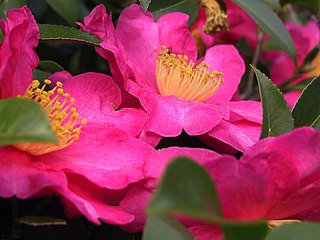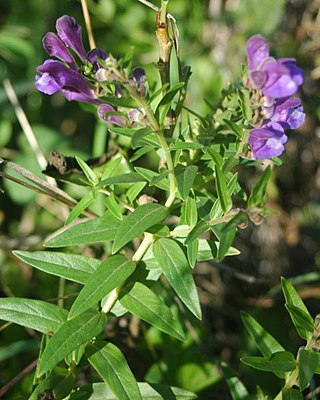
The Magnoliaceae are a flowering plant family, the magnolia family, in the order Magnoliales. It consists of two genera: Magnolia and Liriodendron.

Magnolia is a large genus of about 210 to 340 flowering plant species in the subfamily Magnolioideae of the family Magnoliaceae. The natural range of Magnolia species is disjunct, with a main center in east and southeast Asia and a secondary center in eastern North America, Central America, the West Indies, and some species in South America.

Camellia is a genus of flowering plants in the family Theaceae. They are found in tropical and subtropical areas in eastern and southern Asia, from the Himalayas east to Japan and Indonesia. There are more than 220 described species. Camellias are popular ornamental, tea and woody-oil plants that have been cultivated throughout the world for centuries. To date, over 26,000 cultivars, with more than 51,000 cultivar names including synonyms, have been registered or published.

Hornbeams are hardwood trees in the plant genus Carpinus in the family Betulaceae. The 30–40 species occur across much of the temperate regions of the Northern Hemisphere.

Self-pollination is a form of pollination in which pollen from the same plant arrives at the stigma of a flower or at the ovule. There are two types of self-pollination: in autogamy, pollen is transferred to the stigma of the same flower; in geitonogamy, pollen is transferred from the anther of one flower to the stigma of another flower on the same flowering plant, or from microsporangium to ovule within a single (monoecious) gymnosperm. Some plants have mechanisms that ensure autogamy, such as flowers that do not open (cleistogamy), or stamens that move to come into contact with the stigma. The term selfing that is often used as a synonym, is not limited to self-pollination, but also applies to other type of self-fertilization.

The Styracaceae are a small family of flowering plants in the order Ericales, containing 12 genera and about 160 species of trees and shrubs. The family occurs in warm temperate and subtropical regions of the Northern Hemisphere.

Hu Hanmin was a Chinese philosopher and politician who was one of the early conservative right-wing faction leaders in the Kuomintang (KMT) during revolutionary China.

Cardiocrinum is a genus of bulbous plants of the lily family first described in 1846. They are native to the Himalaya, China, the Russian Far East, and Japan. The bulbs are usually formed at the soil surface. The preferred habitat is woodland. The plants tend to be monocarpic, dying after flowering.

Scutellaria baicalensis, with the common name Baikal skullcap or Chinese skullcap, is a species of flowering plant in the family Lamiaceae.
The Sichuan partridge is a bird species in the family Phasianidae. It is found only in China where it is classified as a nationally protected animal. Its natural habitat is temperate forest. It is threatened by habitat loss.
Henryi, a new Latin adjective used for any of several naturalists named Henry, may refer to:

Sinojackia xylocarpa is a species of flowering plant in the family Styracaceae. It is endemic to eastern China in Jiangsu province, where it occurs at altitudes of 500–800 m. It is threatened by habitat loss.

As baicalin is a flavone glycoside, it is a flavonoid. It is the glucuronide of baicalein.

Hu Xiansu or Hu Hsen-Hsu was a Chinese botanist and scholar. He was the founder of plant taxonomy in China and a pioneer of modern botany and paleobotany research in the country. One of his most notable achievements as a botanist was the discovery of the "living fossil" Metasequoia glyptostroboides in the 1940s, which previously thought to have been extinct for over 150 million years. This has been considered one of the most important botanical discoveries of the 20th century.

Sinojackia rehderiana is a species of flowering plant in the genus Sinojackia.

Cheirostylis, commonly known as fleshy jewel orchids or velvet orchids, is a genus of about sixty species of flowering plants in the orchid family Orchidaceae. Plants in this genus are terrestrial herbs with a caterpillar-like rhizome and a loose rosette of leaves. Small, white, hairy flowers develop as the leaves wither. They are found in tropical Africa, southern Asia, Southeast Asia, Malesia, New Guinea and Australia.

Uncaria rhynchophylla or the cat's claw herb is a plant species used in traditional Chinese medicine.

The flora of China consists of a diverse range of plant species including over 39,000 vascular plants, 27,000 species of fungi and 3000 species of bryophytes. More than 30,000 plant species are native to China, representing nearly one-eighth of the world's total plant species, including thousands found nowhere else on Earth. China's land, extending over 9.6 million km, contains a variety of ecosystems and climates for plants to grow in. Some of the main climates include shores, tropical and subtropical forests, deserts, elevated plateaus and mountains. The events of the continental drift and early Paleozoic Caledonian movement also play a part in creating climatic and geographical diversity resulting in high levels of endemic vascular flora. These landscapes provide different ecosystems and climates for plants to grow in, creating a wide variety of different flora spanning over not just China, but different parts of the world.
Fritillaria sichuanica is a Chinese plant species of the lily family. It is found only in China, found in the Provinces of Gansu, Qinghai, and Sichuan. It belongs to subgenus Fritillaria.

West Lake is a man-made recreational lake in Huicheng District of Huizhou, Guangdong, China. West Lake has a combined area of 20.91-square-kilometre (8.07 sq mi), of which 3.13-square-kilometre (1.21 sq mi) is covered by water. It has been designated as a National AAAAA-level Scenic Spot.

















